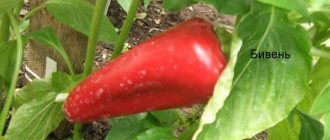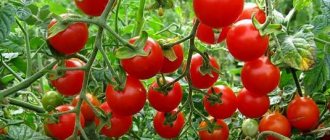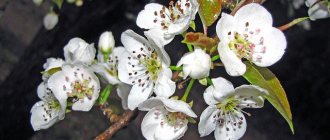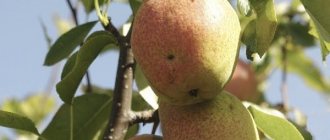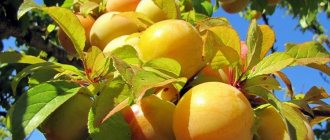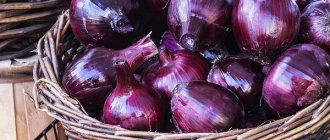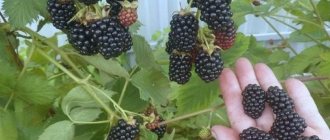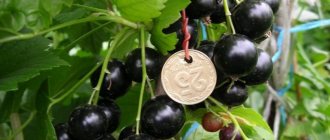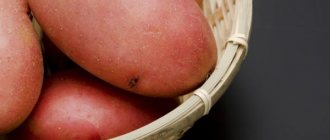The description of the Krasulya pear presents this variety as a variety of very early ripening. The parent varieties of the species are the Little Joy pear and the Late pear, and it received its name for the rich color of the fruits - as they ripen, they change color from pale pink to a bright crimson hue. The Krasulya pear is zoned primarily for cultivation in the Urals, however, it bears fruit well in many other regions of central Russia. The key characteristic of the variety is the tree’s high cold resistance, which makes it possible to cultivate this variety in unfavorable climatic conditions.
Description of the pear variety Krasulya
Krasulya pears belong to the medium-sized category - the height of mature trees rarely exceeds 4 m. As the pear grows, it forms a spreading, rounded crown. The branches of the tree grow almost parallel to the ground, slightly bending their ends upward.
The trunk of the Krasulya variety has a slightly curved shape. The tree bark is peeling.
The leaves of the variety are round, wide, with jagged edges. The leaf blade is not pubescent, unlike the shoots and petioles. Flower buds are large, elongated in shape. Fruiting of the Krasulya pear is mixed - the tree produces fruits both on young shoots and on last year's branches.
The flowers of the variety are large, white, reminiscent of a bowl in appearance. The Krasulya pear blossoms abundantly. It starts in mid-May.
Important! A distinctive varietal feature of this species is the abundance of spines inside the tree crown. They are quite sharp, making harvesting difficult.
Characteristics of the variety
Krasulya belongs to the elite varieties of pears. It was included in this list in 1987. The main distribution is the Urals, Western Siberia. The fruit tree is grown in gardening plots and for industrial purposes.
Drought resistance, frost resistance
The variety is frost-resistant. It should be noted that this characteristic increases with the beginning of fruiting. At the age of 5 years, the Krasulya pear endures harsh winters not only in the Urals, but also in central Russia without loss.
Long periods of lack of rain have a bad effect on the fruiting of the Krasulya pear. When the fruits form and ripen, intensive watering is needed.
Pollinators of Krasulya pear
Krasulya pear is not a self-pollinating tree. Therefore, other pears should be planted nearby for cross-pollination. Suitable varieties: Raduzhnaya and Severyanka. Flowering occurs in mid-May and lasts about two weeks.
Productivity
The main feature of the Krasulya pear is its stable yield. Fruiting occurs after 4-5 years. 30-50 kg of fruit are collected from an adult tree. They ripen in early August. Ripening may occur two weeks earlier or later. It all depends on the weather conditions in the region.
Attention! The volume of pear harvest directly depends on the quality, quantity of fertilizing and frequency of watering.
Application area
Freshly picked Krasulya pears are prepared for future use and consumed fresh. Jams, marmalades, and preserves are prepared from fruits. The variety is not suitable for commercial purposes. Pears do not tolerate transportation well. The storage period for ripe fruits is 10-12 days, in the refrigerator 14 days.
Advantages and disadvantages
If we take into account the reviews of gardeners, the description and photos of the variety, we can highlight the main positive qualities of the Krasulya pear variety.
Advantages:
- winter hardiness;
- productivity;
- high sugar content in the fruit;
- appearance of the fruit;
- undemanding to the composition of the soil;
- resistance to diseases;
- the possibility of growing trees in difficult climatic regions of the country.
Flaws:
- pollinators required;
- the presence of thorns on the crown;
- short shelf life of ripened fruits;
- small size of pear fruit.
Fruit characteristics
The fruits of the Krasulya pear variety are round in shape, but slightly flattened. Their weight varies from 85 g to 120 g. The fruit of the Krasulya pear does not have a funnel, typical of most varieties. Instead, there is a small growth on the fruits, by which this variety can be recognized.
The ripe fruits of the Krasulya pear have an attractive appearance, which formed the basis for the name of the variety. The skin of pears is smooth to the touch, glossy and very delicate.
The color of the fruit is light green with a yellow tint, however, over time, the pears take on red and crimson tones. At the same time, tiny dark dots are visible on the skin.
The pulp of the fruit is tender, slightly loose. Reviews often emphasize the creamy texture of pears and the light oiliness of the fruit. The taste is moderately sweet, without cloying notes.
Pros and cons of the Krasulya variety
In reviews, gardeners mostly note the following advantages of the Krasulya variety:
- attractive appearance of the fruit;
- early stages of ripening;
- excellent taste;
- high winter hardiness;
- good immunity - the pear is resistant to diseases such as scab, fire blight and gall mite;
- high yield rates;
- high sugar content of fruits - during cooking and canning, the amount of additional sugar is reduced significantly.
Despite the rather extensive list of positive qualities of the Krasulya pear, this variety is also not without its disadvantages, which include:
- relatively small fruit size;
- the sweet taste of the fruit may seem cloying to some people;
- the presence of thorns on the shoots;
- short shelf life of the harvested crop - the fruits must be sold or processed within 1-2 weeks.
Advantages and disadvantages of the variety
- excellent immunity;
- you can grow pears in regions with difficult climatic conditions;
- the crop bears fruit consistently and has a high yield;
- good taste, attractive appearance (which is why the variety got the name Krasulya).
- small fruits;
- low shelf life of fruits;
- existing spines in the crown.
Despite minor disadvantages, the Krasulya pear variety is popular among gardeners. It is loved for its productivity, ease of care, and resistance to disease. They are grown both in summer cottages and in industrial production.
Optimal growing conditions
When choosing a site for growing Krasulya pears, you should focus on sunny places, reliably protected from gusts of strong wind. It is also important to pay attention to the level of groundwater in the selected area - it must be at least 2 m below the ground surface.
The composition of the soil is not particularly important, however, plantings, of course, develop better on fertile, loose soils. The planting hole for the pear is dug 2 weeks before planting.
Important! The Krasulya variety grows worst on slightly alkaline soils, however, the composition of the soil can always be adjusted. For example, slightly alkaline soil is usually diluted with sulfur (0.5 kg).
Planting and caring for Krasulya pear
Caring for the Krasulya pear variety involves standard procedures for a gardener:
- weeding;
- loosening the tree trunk circle;
- regular watering;
- timely pruning;
- whitewashing the trunk and skeletal branches;
- preventive measures against pests and diseases;
- cleaning the tree trunk circle from debris and fallen leaves;
- shelter for the winter.
The Krasulya pear variety is planted in the spring, in April. In this case, you should wait until the weather is consistently warm, since the last winter frosts can cause the roots of the seedlings to freeze.
Important! In the south of the country and in the middle zone, Krasulya pear can be planted in open ground in the fall, in the last days of September. This time will be enough for the young plant to gain a foothold in the ground.
Landing rules
Krasulya pears are planted both in spring and autumn. It is recommended to plant trees at a distance of 3-5 m from each other. The variety develops best in areas with loamy and sandy loam soil. Soil acidity should be moderate.
The optimal size of the planting hole is 70-90 cm in diameter and 1 m in depth.
The landing procedure looks like this:
- A nutrient soil mixture is placed at the bottom of the planting hole. It is made independently by mixing earth dug from a hole with humus (2 buckets), sand (1 bucket), potassium chloride (0.5 kg), ash (1 kg), superphosphate (0.5 kg) and dolomite flour (half a bucket) . Fill the hole 1/3 with the resulting mixture.
- After 4-5 days, a small peg is driven in a little from the center - it should be at least 50 cm above ground level.
- A mound of earth from the garden plot is poured into the center of the hole. The roots of the seedling are laid on top of this mound.
- The root system is covered with soil and lightly compacted, without pressing the soil too hard. The root collar should be above ground level.
- The trunk of the seedling is tied to a peg.
- Along the edge of the trunk circle, at a distance of 30 cm from the plant, a small hole is dug for watering. 5 liters of water are poured into it.
- The planting procedure is completed by mulching the seedling. Peat or compost can be used as mulch.
Watering and fertilizing
The Krasulya variety is watered regularly, however, the plantings cannot be flooded - stagnation of water in the soil leads to rotting of the tree root system. The recommended frequency of watering is 2-3 times a month, however, you should largely focus on weather conditions. If it often rains in the growing region, then reduce watering. During periods of abnormal heat and prolonged drought, plantings are watered more often.
One tree uses an average of 3 buckets of water.
Advice! It is necessary to water pears exclusively in the area around the trunk circle, around the perimeter. If you pour water under the root, you can cause irreparable damage and cause sunburn on the lower part of the trunk.
They begin to feed the Krasulya variety in the 2nd year of life. After this, fertilizers are applied to the soil every 3-4 years. In the spring, preference is given to nitrogen-containing organic fertilizers, however, at the end of summer and autumn, gardeners switch to fertilizing with phosphorus and potassium.
Trimming
In order to form the correct crown, seedlings are pruned immediately after planting. The growth of young shoots is stimulated by cutting shoots to 1/3 of the total length.
In a pear about 2 years old, the second largest shoot is shortened by 2/3. The remaining branches are cut by 1/3.
Trees older than 3 years are pruned exclusively for sanitary purposes. Shoots growing inside the crown are cut off from pears, and broken and dried branches are also removed.
Advice! It is recommended to lubricate all cuts with garden varnish.
Whitewash
It is recommended to cover the pear trunk with whitewash in November or December. This is done in order to provide the tree with protection from frost damage and sunburn in the spring, when the snow begins to melt.
Preparing for winter
Krasulya pear is a winter-hardy variety that is not insulated in central Russia. This does not apply to young seedlings, which are still too weak to survive low temperatures. It is better to cover trees under 2 years of age for the winter by first sprinkling the tree trunk with mulch.
Important! It is not recommended to use roofing felt and film as insulation - these materials do not allow air to pass through.
Covering the trunk with spruce branches will provide protection from rodents.
Further care
No special effort is required from the gardener. Everything is standard:
- Particular attention should be paid to young seedlings. After 3-5 years, all necessary measures are carried out as needed.
- Water Krasulya once a week (2-3 buckets of water). In dry weather at least 2-3 times. Irrigation is also carried out during tree flowering and fruit ripening. Each time after watering, the soil is loosened and mulched with peat.
- The plant is fed annually in early spring (nitrogen composition, urea), during budding (phosphorus fertilizers, wood ash). In the summer, chicken droppings and slurry diluted with water are used, and in the fall, phosphate-potassium substances are used.
- The Krasulya variety requires annual pruning. The initial work needs to be done after planting the tree. The shoots of the main branches are shortened by a third. This activates their growth. Sick, broken, damaged branches are also removed. The procedure is carried out in spring and autumn as needed.
- In spring and autumn, the orchard is cleared of fallen leaves and dry grass, the tree trunks are dug up, and the trunks are whitened.
Diseases and pests
The Krasulya pear is quite resistant to pests and rarely gets sick. This not only makes it easier to care for garden crops, but also allows you to save on chemical and natural treatments for fungus and other infections.
On the other hand, this does not mean that the Krasul pear is never affected by diseases. In particular, the variety is quite vulnerable to the following diseases:
- powdery mildew;
- fruit rot;
- rust.
The fact that pears have been affected by powdery mildew is indicated by whitish spots on the leaves of the trees. The risk of plantings being damaged by powdery mildew can be minimized through preventive measures in the spring months. The disease is prevented by timely treating the tree with a solution of colloidal sulfur every 2 weeks. 2-3 sprayings per spring are enough. In autumn, the variety is treated with Bordeaux mixture.
If the pear does get sick, the fight against powdery mildew is carried out using potent chemicals. The following drugs are suitable for this:
- "Topaz";
- "Skor";
- "Vitaros";
- "Previkur".
Fruit rot overtakes Krasulya pear plantings during periods of high humidity - in the summer, when it rains too often. The first signs of the disease are the appearance of brownish spots on the pulp of the fruit.
Important! All affected fruits must be collected and burned.
Prevention of fruit rot involves treating trees with Bordeaux mixture and urea solution.
Krasulya pears are sprayed against rust with the following fungicides:
- "Strobe";
- "Home";
- "Medex";
- "Azofos".
Treatments are carried out both before and after flowering.
Pests practically do not bother this variety, however, the most likely threats to plantings can be identified:
- leaf roller;
- pear sucker;
- pear moth.
Any industrial insecticide is suitable to combat these insects. Well proven:
- "Karbofos";
- "Fitoverm";
- "Iskra-M";
- "Kinmiks";
- "Decis".
There are also traditional ways to protect plantings from pests:
- Leaf roller larvae are destroyed using an infusion of tobacco and shag. To do this, 200 g of tobacco is mixed with 200 g of shag and poured with 10 liters of water. The resulting solution is kept for 2 days, filtered and diluted with another 5 liters of water. The infusion is used to spray pears.
- Adult pear worms are repelled by fumigation of trees with tobacco smoke.
- In the spring, the pear moth is caught in special fishing belts that are attached to tree trunks. Butterflies are caught using baits.
Reviews from gardeners about the pear variety Krasulya
Serebrenikova Anastasia Pavlovna, 64 years old, St. Petersburg
Excellent variety, one of my favorites. I don’t see any shortcomings with it, except for the skin being too thin. Yes, this is a plus for most, but I don't like it. Inconvenient to harvest. Everything must be done very quickly, otherwise the pears will fall to the ground and be crushed by the impact, or even break completely. As a result, part of the harvest is lost, and the broken pulp attracts hordes of wasps.
Petrov Danil Ivanovich, 39 years old, Ekaterinburg
A neighbor in the country once brought me seedlings of the Krasulya variety. I don’t consider myself an avid gardener, but then I decided to go crazy and plant this pear tree. I have never regretted it. The pears are excellent, the whole family enjoys eating them. I don’t particularly like to tinker in the garden, but this variety grows well even without my participation. This is what I like most. Pear for lazy summer residents who love sweets. All I do with my tree is water it from time to time, feed it a couple of times and whiten it.
Sinichkina Miroslava Alekseevna, 45 years old, Moscow
I love fruits, but pears are my weakness. I have been growing pears for many years, I have long identified my favorites and do not buy new varieties. The exception was the Krasulya pear - I was very attracted by the photos of the delicious fruits, and the reviews describing the variety were very flattering. I don’t regret adding to the collection - the pear is very tasty, moderately sweet, as if creamy. It withstands frosts well, and, in general, the tree is beautiful.
Selection of seedlings
The high yield of the variety directly depends on the quality of the seedlings. When choosing young trees, you should first of all pay attention to the roots of the tree. They should not contain rotten parts or roots with signs of disease. It is necessary that the root part of the tree is dry and brownish in color.
When purchasing, look at the container in which the seedling is sold.
When choosing a pear seedling, you need to inspect the branches; they should not be broken or damaged. You can buy a tree both in early spring and in autumn.
Growing pear seedlings in a nursery
Choosing a landing site
For the growth of a seedling, it is also important to choose the right site for planting. The Krasulya variety prefers to grow in the sun, where there is a lot of sunlight during the day. But because of its spreading branches, the pear does not “like” close proximity to other trees; it prefers to grow separately, on the sidelines. This variety is not recommended to be planted under large trees, as they will not provide enough sunlight for the pear to grow.
It is preferable to plant pears in open areas where there is a lot of sun and space.
The soil
As for the soil, the Krasul variety is not capricious and easily takes root on any soil, clayey, sandy. However, you should not plant seedlings in wetlands where groundwater is close.
Due to excess moisture in the soil, the roots of the pear can rot, the plant itself loses its growth rate, and the fruits become soft and quickly fall off. Any soil is suitable for planting, black soil, sandy or slightly clayey.
Time to board
Krasulya pear can be planted both in spring and autumn. In spring, it is better to plant a tree in mid-April or early May, when the frosts have passed and the soil has been warmed by the sun.
If planting occurs in the autumn, then it is important to have time to plant the seedling before the onset of the first frost, or better yet, a month before the onset of cold weather. Suitable time for planting is from late September to early November . Before the cold weather, the tree will have the opportunity to take root in a new place and survive the first winter.
Ripe Krasulya pears on a bush
Landing technology
Planting the Krasulya pear is not difficult; the variety quickly takes root in a new place and does not require special care.
- Planting a pear should begin by preparing a hole. Its size depends on the root system of the seedling; the larger it is, the wider and deeper the hole will be needed.
Before planting, you also need to inspect the roots of the tree; if they are tangled, they can be safely shortened or cut, but not too much. Before planting, it is recommended to dip the pear roots in a bucket with a solution of potassium permanganate. This will not only neutralize the roots, but also protect the tree from many diseases. - Next, lay sawdust, small pebbles, and humus well at the bottom of the hole. The soil should also be loose, moist, without lumps and roots of other plants.
- After the drainage is laid, you need to pour a bucket of water and wait until the earth absorbs the moisture and settles.
- Then the roots are carefully laid at the bottom , the tree should stand strictly vertical. The roots are covered with earth, after which the pear must be watered with 2-3 buckets of water.
- After planting, the ground around the tree should be well mulched , so it will retain moisture longer. The tree will need the next watering every other day; 1-2 buckets of water will be enough.
In general, the Krasulya pear quickly takes root in a new place, especially if the seedling is healthy. If planted correctly, the pear will take root within a couple of weeks, or even earlier. And the first leaves after a month are a sure sign that the seedling has taken root and begun to grow. Now only proper care will help you harvest kilograms of crops.


